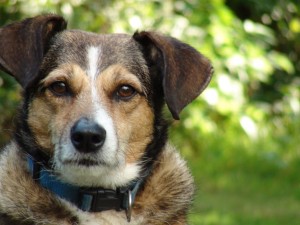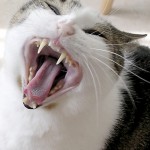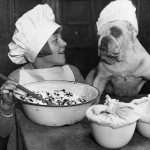The History of Dog’s Bread
 In the late 1850s, an American inventor named Jack Spratt was on a visit to England. One day, as he was walking along the peers he noticed a group of sailors throwing their discarded biscuits to stray dogs. The biscuits, nicknamed “hardtacks” or “molar breakers,” were made of flour, water, a little salt, and baked until they were hard as a rock. They were considered inferior food, often infested with grubs, weevils, and larva (yummy, protein). The biscuits had a shelf life of 50 years, which is why sailors took them to sea, and why Civil War soldiers took them to war. In a way, I guess, you could call hardtacks the first MREs.
In the late 1850s, an American inventor named Jack Spratt was on a visit to England. One day, as he was walking along the peers he noticed a group of sailors throwing their discarded biscuits to stray dogs. The biscuits, nicknamed “hardtacks” or “molar breakers,” were made of flour, water, a little salt, and baked until they were hard as a rock. They were considered inferior food, often infested with grubs, weevils, and larva (yummy, protein). The biscuits had a shelf life of 50 years, which is why sailors took them to sea, and why Civil War soldiers took them to war. In a way, I guess, you could call hardtacks the first MREs.
Nonetheless, Spratt had an epiphany. He saw an untapped commodity: biscuits for dogs. Immediately, he created his own formula. He added a little vegetables, a little meat, a little blood, patented it, and named his company Spratt’s Meat Fibrine Dog Cakes. By the 1890s, the dog biscuits made its way to the American market. Thus, the pet food industry began.
Actually, dog biscuits weren’t anything new. It had been a British concoction since the 1820s. In several 19th Century British magazines, references were made to dog food. In Sporting Magazine, 1828, “being in the neighbourhood of Maidenhead, I inspected Mr. Smith’s dog-biscuit manufactory, and was surprised to find he has been for a long period manufacturing the enormous quantity of five tons a-week !” Five tons? That’s a lot of biscuits considering pet ownership in 19th Century England was considered a luxury and only a few owned an animal companion (as opposed to the necessity of a working farm animal).
Dog-biscuit is a hard and well-baked mass of coarse, yet clean and wholesome flour, of an inferior kind to that known as sailors’ biscuit; and this latter substance, indeed, would be the best substitute for the former with which we are acquainted. A bag of dog-biscuit of five shillings’ value, will be an ample supply for a yard-dog during the year: it should be soaked in water, or ” pot liquor,” for an hour or two ; and if no meat be at hand, a little dripping or lard may be added to it while softening, which will make a relishing meal at a trifling cost. We have for many years known the utility of the plan thus advocated, and we earnestly recommend all who value the safety of the community and their own (to say nothing of the happiness of the canine race), to make trial of the rational and feasible plan which we have detailed.” (1841) ~ “Agriculturalist’s Notebook – VXII,” William Blackwood, The Quarterly Journal of Agriculture, Vol XI, 1841.
But, even in those days they knew biscuits was an unnatural food for dogs.
In the south of England it is much the fashion to give sporting-dogs a food called dog-biscuit instead of barley-meal, and the consequences resulting from this simple aliment are most gratifying. Barley-meal, indeed, is an unnatural food, unless it be varied with bones, for a dog delights to gnaw, and thus to exercise those potent teeth with which nature has furnished him ; his stomach, too, is designed to digest the hard and tough integument of animal substance; hence, barleymeal, as a principal portion of his subsistence, is by no means to be desired. In small private families it is not always possible to obtain a sufficiency of meat and bones for the sustenance of a dog, and recourse is too frequently had to a coarse and filthy aliment, which is highly objectionable, especially if the creature be debarred from taking daily exercise, fettered by a chain, and restricted, by situation, from obtaining access to grass; and no one who has not watched the habits of our faithful allies (as we have done), can be aware of the absolute necessity which exists for his obtaining a constant supply of it. If no other good effect resulted from it than the sleekness of his coat and clearness of his skin, these benefits ought to he procured for him; but when his health and comfort are to be also ensured, who, that has a grain of benevolence in his disposition, would hesitate to perform so simple and gratifying an act of duty? ~ “Agriculturalist’s Notebook – VXII,” William Blackwood, The Quarterly Journal of Agriculture, Vol XI, 1841
In the Middle Ages (and, long before biscuits) it was common for European Royalty to have special cooks assigned to their hunting dog kennels. Kennel cooks would make huge stews of grains and vegetables with some meat or organs (the heart, liver, lungs of various livestock). And, in the 1800s, Empress Tzu Hsi of China was known to feed her Pekingese shark fins, quail breasts, and antelope milk. And, European nobility fed their dogs roast duck, cakes, candies, and even liquor.
In those times, meat was expensive. The average family did not share such luxury with their dogs. Instead, they were fed only what the owners could spare. A typical domesticated dog’s diet consisted of crusts of bread, bare bones, potatoes, cabbage, or whatever the dog could scrounge on their own, such as, garbage or rodents.
If we go back even further in time, let’s say, more than 2,000 years, the Romans spoke of “dog’s bread.” It was made of bran and was regarded as poor quality food. The 1st Century Roman poet Juvenal refers to “dog’s bread” as filth. In his poem Les Comedies, Book II, Satire 6, he writes “And bit into the filth of a dog’s bread.” In later centuries, “to give [someone] dog’s bread” was an analogy that meant “to punish or mistreat.” This refers to a bread laced with poison, needles, and broken glass, and then fed to dogs in order to kill them.
However, not all ancient texts give out such disparaging description of dogs or dog food. Roman poet and philosopher Marcus Terentius Varro (BC 116-28) wrote the first agricultural manual. In it he advised giving farm dogs barley bread soaked in milk and bones from slaughtered sheep. “Dogs … must be kept as a matter of course, for no farm is safe without them …You should keep a few active ones rather than a pack, and train them to keep watch at night and sleep indoors during the day”…”Kindness and common decency, he says “should extend to oxen as well as to slaves and to dogs.”
What’s the deal on humans feeding a carnivore dog bread? Well, bread has long been a staple in people’s diet. And what’s good for a human is probably good for a dog. Right? Or, does anthropomorphism have anything to do with it? I think so.
Incorrectly feeding dogs a cooked omnivore diet comes from the idea that only wild, untamed dogs eat raw meat, and that domesticated dogs need to be more civilized. Therefore, dogs should eat “like humans.” This became the motto behind the commercial pet food industry. It has nothing to do with the dog’s (or cat’s) biology or anatomy. It all has to do with humans projecting their own needs and wants on animals.
However, we may want our animals to be more civilized, but we’re still not going to feed them the best. In olden times, dog’s bread was considered filth, unfit for human consumption. Today, nothing has changed. You may think we’re feeding our beloved pets better, but we’re not. Commercial pet food is made from the filth of rendering factories, from the “unfit for human consumption” in the slaughterhouses. And, from the total disregard of dogs and cats physiology.
Below is a video of the documentary “A Dog’s Breakfast.” It is a very interesting expose of the Pet Food Industry. In February 2011, the documentary was quickly cancelled from being aired on American television. I guess the networks didn’t want to offend their sponsors.
But, you can watch it now:











